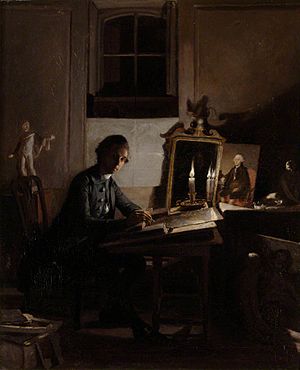Richard Morton Paye facts for kids
Richard Morton Paye (1750–1820) was a very important English painter. He was known for his unique style and for painting everyday people. Even though he was considered one of the most talented artists in England during his time, he faced many challenges later in life and died without much money.
Contents
Early Life and Art Training
Richard Morton Paye was born in Botley, Hampshire, England, in 1750. His parents were John and Elizabeth Paye. When he was young, he worked in a craft called chasing. This means he decorated metal surfaces by pushing and shaping them.
Exhibiting at the Royal Academy
Paye first showed his art at the Royal Academy in 1773. This was a big deal for artists. He had six pieces accepted for their summer show. These included two oil paintings and four wax models. People said his wax models were as good as those by George Michael Moser.
Over the next 30 years, Paye showed his art at the Royal Academy 66 times. People really liked his work. A book published after his death said that his paintings were noticed and approved by the best art experts, even when placed next to famous artists like Sir Joshua Reynolds.
Paye also showed his art at the Society of Artists and the British Institution.
Paye's Art Style and Subjects
Like another famous artist, William Hogarth, Paye loved to paint ordinary people. He especially liked to show street children in London. His style often reminded people of the Spanish painter Bartolomé Esteban Murillo.
Experts today say that Paye's painting methods and how he used colors were very new for his time. He was also a perfectionist. He spent a lot of time on his paintings. One of his supporters, a writer named John Wolcot, even joked that Paye would "paint himself into a gaol" (meaning he'd spend too much time on art and get into trouble). Paye was not good at business and often faced difficulties because of his artistic nature.
His paintings were known for being very detailed but not overly complicated. People also praised his use of light and shadow, called chiaroscuro. This made his pictures look very real and deep.
Personal Challenges
Paye had a difficult relationship with his main supporter, John Wolcot. Wolcot did not like it when Paye made fun of him in his art. In 1785, Paye showed a painting called "Portrait of a Sulky Boy." Wolcot thought the boy in the painting was his own son, and he got very angry. His anger grew when Paye published a funny picture of Wolcot as a bear painting. After this, Wolcot stopped supporting Paye.
Things got worse for Paye when he had a stroke. This meant he lost the use of his right arm. But Paye was determined. He learned to paint again using only his left hand! He continued to have his paintings accepted at major art shows in London.
Even with his amazing effort, he became very poor. He received help from the Artists' Benevolent Fund, a charity for artists. Despite his hardships, his love for art never faded. People said that his passion and talent kept him going through all his difficulties.
Dealing with Art Dealers and Critics
Sometimes, Paye's paintings were sold as if they were made by other famous artists like Diego Velázquez or Thomas Gainsborough. This happened because Paye often did not sign his work. Because of this, Paye felt that art dealers and critics never gave him enough credit for his own talent.
One of his most famous paintings is "St. James' Day," shown in 1788. It shows many different Londoners at an oyster stand on a summer night. In the painting, there's a dog stealing a chicken, and on its collar, it says "critick." This was Paye's way of showing his feelings about art critics.
Later Life and Legacy
Richard Morton Paye showed his last painting in 1815. It was called 'The Gout; or a Lecture on Patience'. A note next to it said, 'Painted with the left hand, after losing the use of the right by a paralytic fit.' This showed his amazing strength and dedication.
While Richard Morton Paye's career slowed down, his daughter Eliza became a successful artist. She showed her work at the Royal Academy 32 times. His son, Richard Morton Paye Jnr., also became a successful engraver.
Richard Morton Paye passed away in 1820. He was buried at St. James Church in Clerkenwell. Even though he faced many challenges, he is remembered as a truly talented artist.
Gallery







